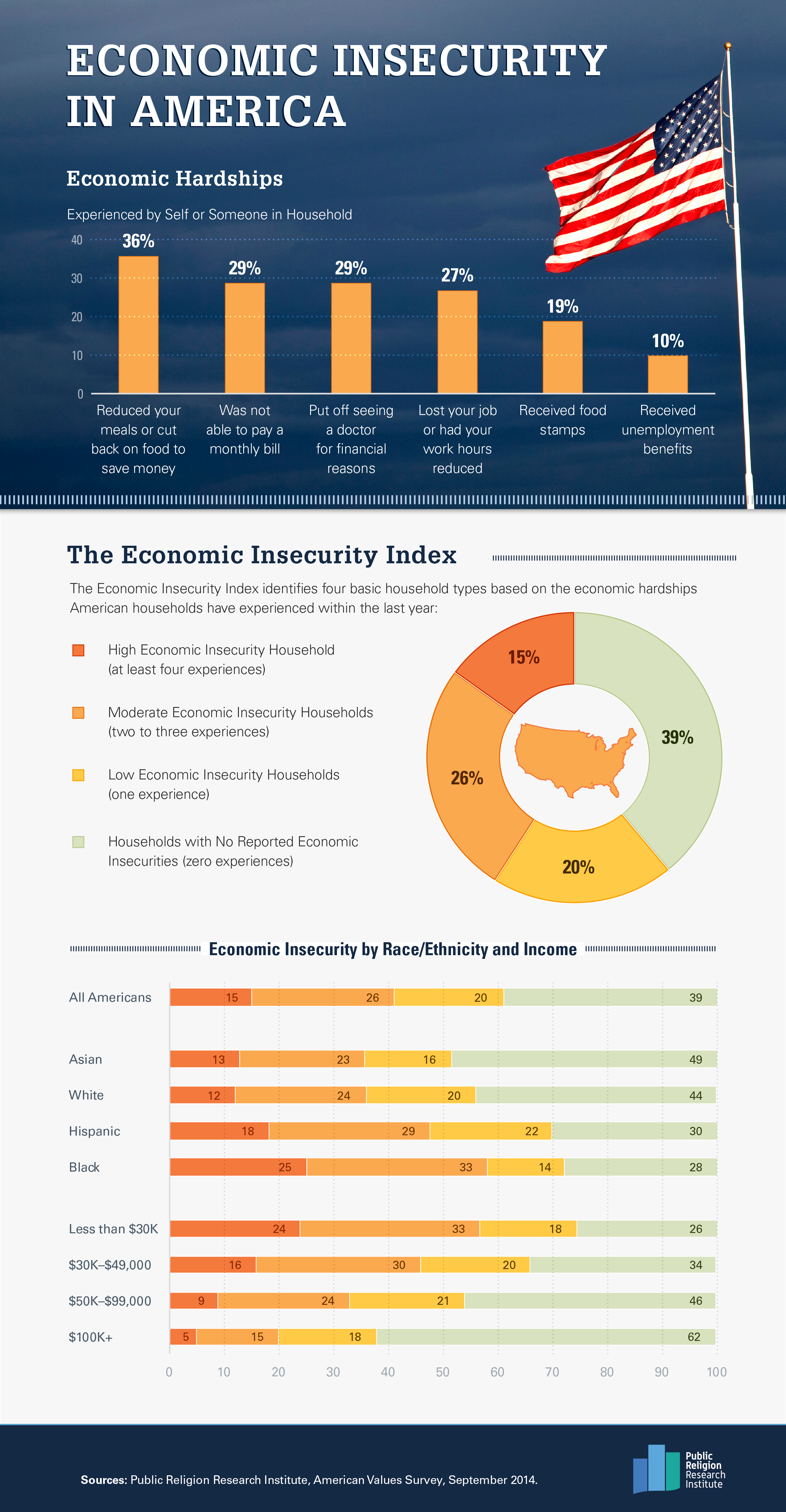 Economic hardships continue to plague the American public, which may be why so many think our economy is doing worse than it actually is. PRRI’s 2014 American Values Survey reveals a majority of Americans (61 percent) report that they’ve experienced at least one economic hardship in the last year. The most commonly reported economic hardship is food insecurity, although issues with bills and health expenses take a close second and third place, respectively. More than one-third (36 percent) of Americans report that they or someone in their household had to reduce meals or cut back on food to save money over the course of the past year. In addition, nearly 3-in-10 (29 percent) Americans say they or someone in their household were unable to pay a monthly bill or had to put off seeing a doctor for financial reasons. In order to better understand the spectrum of households with economic hardships, PRRI created the Economic Insecurity Index (EII), developed from six specific measures of economic hardship. The EII finds that approximately 4-in-10 Americans live in high (15 percent) or moderate (26 percent) economic insecurity households, while 6-in-10 Americans live in households with low (20 percent) or no (39 percent) reported economic insecurity. Economic insecurity varies drastically by race and income. Although the latter may seem obvious, the racial divides may come as a surprise. At 25 percent, black Americans are twice as likely to live in a high economic insecurity household than white Americans. Almost half (49 percent) of Asian Americans live in a household with no reported economic insecurities. Hispanic Americans most closely match Americans overall: 18 percent live in households with high economic insecurity, 29 percent in moderate insecurity, 22 percent in low insecurity, and 30 percent in households with no reported economic insecurity. Considering these findings, it’s no wonder Americans are expressing concern about the economic future for themselves and their children. Read the entire AVS report to find out more.
Economic hardships continue to plague the American public, which may be why so many think our economy is doing worse than it actually is. PRRI’s 2014 American Values Survey reveals a majority of Americans (61 percent) report that they’ve experienced at least one economic hardship in the last year. The most commonly reported economic hardship is food insecurity, although issues with bills and health expenses take a close second and third place, respectively. More than one-third (36 percent) of Americans report that they or someone in their household had to reduce meals or cut back on food to save money over the course of the past year. In addition, nearly 3-in-10 (29 percent) Americans say they or someone in their household were unable to pay a monthly bill or had to put off seeing a doctor for financial reasons. In order to better understand the spectrum of households with economic hardships, PRRI created the Economic Insecurity Index (EII), developed from six specific measures of economic hardship. The EII finds that approximately 4-in-10 Americans live in high (15 percent) or moderate (26 percent) economic insecurity households, while 6-in-10 Americans live in households with low (20 percent) or no (39 percent) reported economic insecurity. Economic insecurity varies drastically by race and income. Although the latter may seem obvious, the racial divides may come as a surprise. At 25 percent, black Americans are twice as likely to live in a high economic insecurity household than white Americans. Almost half (49 percent) of Asian Americans live in a household with no reported economic insecurities. Hispanic Americans most closely match Americans overall: 18 percent live in households with high economic insecurity, 29 percent in moderate insecurity, 22 percent in low insecurity, and 30 percent in households with no reported economic insecurity. Considering these findings, it’s no wonder Americans are expressing concern about the economic future for themselves and their children. Read the entire AVS report to find out more.
4-in-10 Americans Experiencing Economic Insecurity
Topics:
Economy